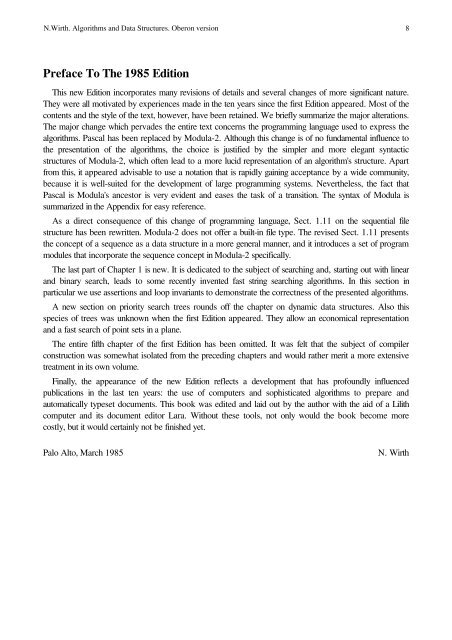Algorithms and Data Structures
Algorithms and Data Structures
Algorithms and Data Structures
You also want an ePaper? Increase the reach of your titles
YUMPU automatically turns print PDFs into web optimized ePapers that Google loves.
N.Wirth. <strong>Algorithms</strong> <strong>and</strong> <strong>Data</strong> <strong>Structures</strong>. Oberon version 8<br />
Preface To The 1985 Edition<br />
This new Edition incorporates many revisions of details <strong>and</strong> several changes of more significant nature.<br />
They were all motivated by experiences made in the ten years since the first Edition appeared. Most of the<br />
contents <strong>and</strong> the style of the text, however, have been retained. We briefly summarize the major alterations.<br />
The major change which pervades the entire text concerns the programming language used to express the<br />
algorithms. Pascal has been replaced by Modula-2. Although this change is of no fundamental influence to<br />
the presentation of the algorithms, the choice is justified by the simpler <strong>and</strong> more elegant syntactic<br />
structures of Modula-2, which often lead to a more lucid representation of an algorithm's structure. Apart<br />
from this, it appeared advisable to use a notation that is rapidly gaining acceptance by a wide community,<br />
because it is well-suited for the development of large programming systems. Nevertheless, the fact that<br />
Pascal is Modula's ancestor is very evident <strong>and</strong> eases the task of a transition. The syntax of Modula is<br />
summarized in the Appendix for easy reference.<br />
As a direct consequence of this change of programming language, Sect. 1.11 on the sequential file<br />
structure has been rewritten. Modula-2 does not offer a built-in file type. The revised Sect. 1.11 presents<br />
the concept of a sequence as a data structure in a more general manner, <strong>and</strong> it introduces a set of program<br />
modules that incorporate the sequence concept in Modula-2 specifically.<br />
The last part of Chapter 1 is new. It is dedicated to the subject of searching <strong>and</strong>, starting out with linear<br />
<strong>and</strong> binary search, leads to some recently invented fast string searching algorithms. In this section in<br />
particular we use assertions <strong>and</strong> loop invariants to demonstrate the correctness of the presented algorithms.<br />
A new section on priority search trees rounds off the chapter on dynamic data structures. Also this<br />
species of trees was unknown when the first Edition appeared. They allow an economical representation<br />
<strong>and</strong> a fast search of point sets in a plane.<br />
The entire fifth chapter of the first Edition has been omitted. It was felt that the subject of compiler<br />
construction was somewhat isolated from the preceding chapters <strong>and</strong> would rather merit a more extensive<br />
treatment in its own volume.<br />
Finally, the appearance of the new Edition reflects a development that has profoundly influenced<br />
publications in the last ten years: the use of computers <strong>and</strong> sophisticated algorithms to prepare <strong>and</strong><br />
automatically typeset documents. This book was edited <strong>and</strong> laid out by the author with the aid of a Lilith<br />
computer <strong>and</strong> its document editor Lara. Without these tools, not only would the book become more<br />
costly, but it would certainly not be finished yet.<br />
Palo Alto, March 1985<br />
N. Wirth
















